The intoxicating scent of a quintessential Italian dish permeating the kitchen is a sensation unparalleled. The harmonious fusion of lemon, butter, and capers evokes the vibrant ambiance of Rome’s streets, where the allure of the Mediterranean has enthralled countless generations. Tonight, I extend an invitation to embark on a gastronomic adventure, delving into the enduring charm of Chicken Piccata. This dish, a cornerstone in Italian-American cuisine, promises to captivate your senses.
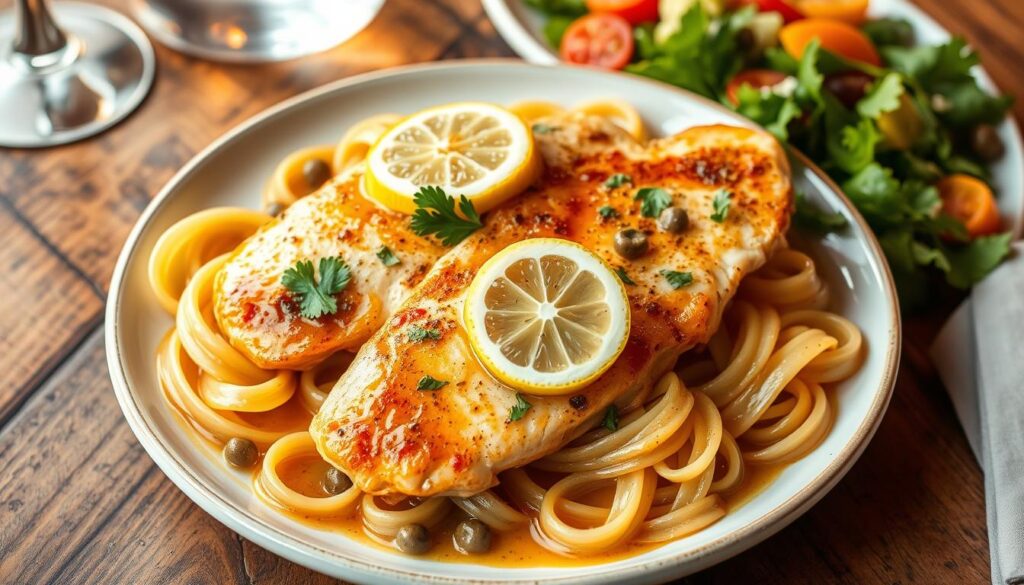
Chicken Piccata exemplifies the Italian penchant for culinary brilliance, where the essence of simplicity is elevated through the use of premium ingredients. This dish transforms the humble chicken breast into a masterpiece, thanks to a zesty lemon-caper sauce that harmonizes with the succulent, pan-seared meat. Whether you are an experienced chef or a novice, mastering Chicken Piccata is a journey that will astound your loved ones with your culinary expertise.
Introduction to Chicken Piccata: An Italian-American Favorite
Chicken piccata, a quintessential Italian-American restaurant dish, has captured the affections and culinary endeavors of numerous gastronomes. Its genesis lies in Italy’s profound culinary heritage, where it has undergone transformation, assimilating into the preferences of American palates.
Origins in Italian Cuisine
The lineage of chicken piccata is rooted in the traditional Italian preparation, scaloppine. Scaloppine, a delicate, tender cutlet, typically derived from veal, undergoes pan-frying and is complemented by a delectable sauce. This technique was prevalent in Italy, applied to various meats, including chicken.
Evolution in American Restaurants
Italian immigrants, carrying their culinary legacy to the United States, contributed to the emergence of Italian-American cuisine. Chicken piccata, a fixture on many restaurants‘ menus, garnered acclaim for its unique yet relatable flavors. American chefs, in turn, refined the dish, incorporating diverse ingredients and presentation styles to meet the changing tastes of their clientele.
Presently, chicken piccata stands as a cherished classic, embodying the synergy of Italian and American culinary arts. Its zesty, tangy essence and tender, succulent chicken have solidified its status as a preferred option for those desiring a comforting yet refined dining experience.
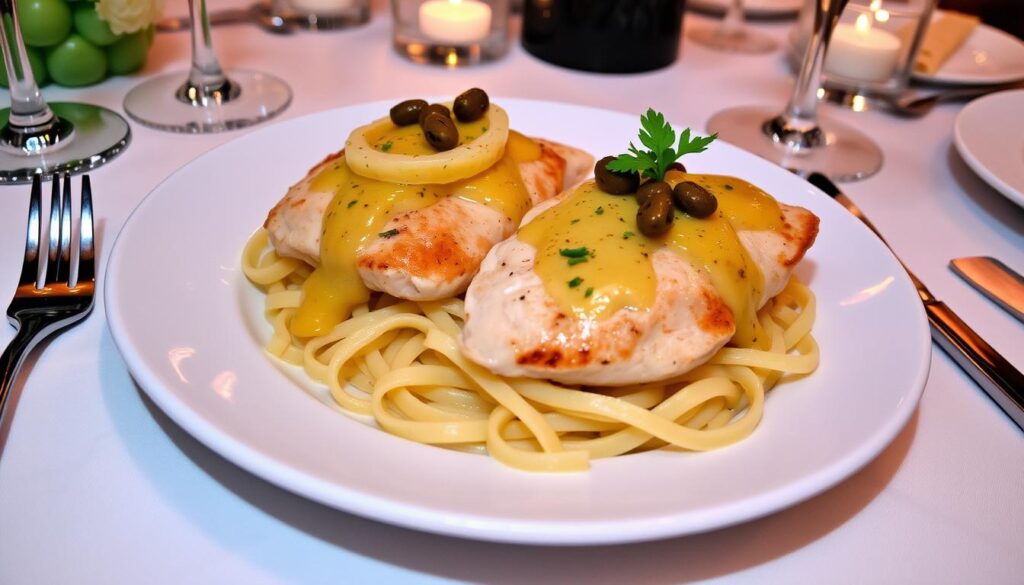
Essential Ingredients for Authentic Chicken Piccata
The creation of a quintessential chicken piccata necessitates a confluence of critical components, each contributing uniquely to the dish’s distinctive taste. At its core lies the chicken breast, a prerequisite of superior quality and freshness, meticulously prepared to perfection. The ensemble is complemented by the inclusion of fresh lemons, a delectable lemon butter sauce, the salty essence of capers, and a judicious addition of white wine.
Initiating the preparation of authentic chicken piccata commences with the selection of boneless, skinless chicken breasts. These are then gently pounded to achieve uniform thickness, ensuring uniform cooking. The lemon butter sauce serves as the dish’s focal point, marrying the zesty essence of fresh lemon juice with the velvety smoothness of butter. The inclusion of capers imparts a salty, savory dimension, while the white wine subtly enriches the flavor spectrum.
With these fundamental ingredients in hand, one is poised to excel in the art of chicken piccata. An exploration into the selection and preparation of each component will unveil the secrets to crafting a dish that embodies the quintessence of this beloved Italian-American classic.
| Ingredient | Purpose |
|---|---|
| Chicken Breasts | The star of the dish, providing the protein and structure |
| Lemon Butter Sauce | The signature flavor, combining the brightness of lemon with the richness of butter |
| Capers | Adds a briny, salty punch to balance the other flavors |
| White Wine | Provides subtle complexity and depth to the sauce |

Selecting and Preparing the Perfect Chicken Breasts
In the art of crafting chicken piccata, the selection and preparation of chicken breasts stand as the foundational elements. Begin by acquiring fresh, boneless, and skinless chicken breast fillets. Opt for breasts that exhibit uniform size and thickness, a prerequisite for uniform cooking.
Proper Butterflying Technique
To achieve the signature thin, scaloppine-style cutlets, a precise butterflying technique is imperative. The process involves the following steps:
- Position the chicken breast on a clean cutting board.
- Incise the breast horizontally, halting just before severing completely.
- Unfold the breast, akin to opening a book, resulting in two halves of even thickness.
Achieving the Right Thickness
Post-butterflying, employ a meat mallet or the underside of a heavy skillet to gently pound the breasts to a uniform thickness of approximately 1/4 inch. This step is critical for ensuring the scaloppine cooks uniformly and swiftly.
Seasoning Tips
Proper seasoning is the key to unlocking the full flavor of your chicken piccata. Season the butterflied and pounded chicken breasts liberally with salt and freshly ground black pepper. Consider augmenting with additional spices such as garlic powder or dried herbs to enhance the dish’s lemon and caper notes.
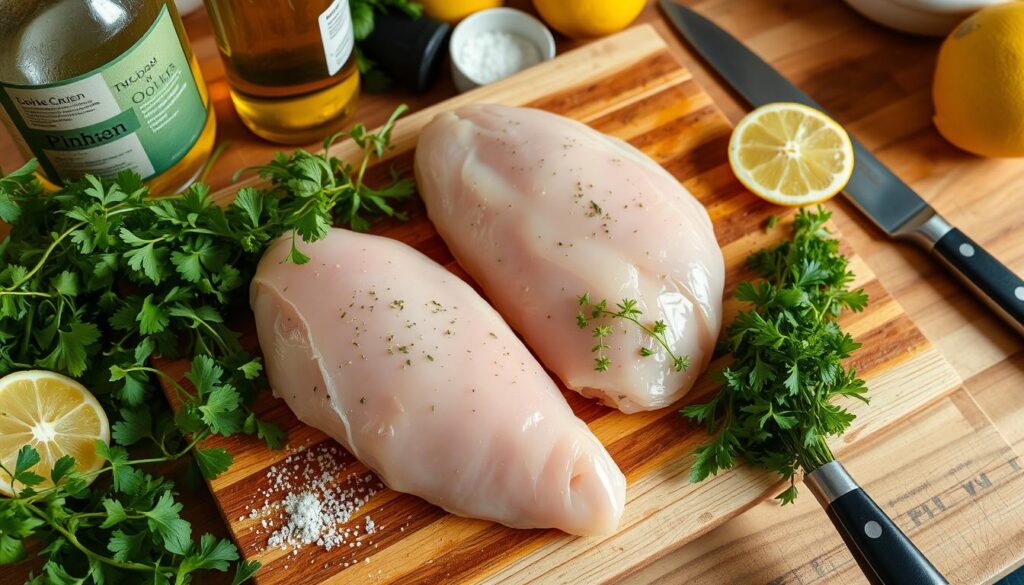
| Step | Description |
|---|---|
| Selecting | Choose fresh, boneless and skinless chicken breast fillets that are uniform in size and thickness. |
| Butterflying | Slice the chicken breast horizontally, stopping just short of cutting all the way through, and open it like a book. |
| Pounding | Use a meat mallet or the bottom of a heavy skillet to gently pound the butterflied chicken breast to an even thickness of about 1/4 inch. |
| Seasoning | Generously season the butterflied and pounded chicken breast with salt, pepper, and other spices as desired. |
The Art of Making Lemon Butter Sauce
The lemon butter sauce, a quintessential component of classic chicken piccata, seamlessly integrates the zesty essence of citrus with the velvety smoothness of butter. Achieving mastery over this sauce is imperative for elevating the dish to its full gastronomic splendor, providing an authentic Italian-American culinary experience. We shall dissect the intricacies of crafting the quintessential lemon butter sauce for your chicken piccata.
To achieve a harmonious balance in the lemon butter sauce, one must carefully calibrate the tartness of lemon juice against the lusciousness of butter. The essence lies in the slow emulsification of these two elements, ensuring a seamless fusion. Begin by sautéing minced garlic in a skillet with a judicious amount of olive oil until it releases its aromatic fragrance. Subsequently, deglaze the pan with a measured splash of white wine, meticulously scraping up any residual browned bits from the chicken to imbue the sauce with an additional layer of flavor.
Following this, introduce freshly squeezed lemon juice into the mixture, adjusting the quantity to suit your individual taste preferences. The lemon juice should impart a vibrant, tangy quality that harmoniously complements the butter’s richness. Gradually incorporate cold butter cubes, whisking incessantly to prevent the butter from separating or curdling, ensuring a silky, creamy texture.
Upon achieving the desired consistency, season the sauce with salt and pepper to refine the flavor profile. Consider adding a sprinkle of fresh parsley or a pinch of lemon zest to further accentuate the citrus notes and add a burst of freshness as a final flourish.
The success of your lemon butter sauce hinges on the patience and precision you employ. Invest time in perfecting the flavors and technique, allowing the sauce to develop a seamless harmony. With consistent practice, you will master the art of crafting a lemon butter sauce that transcends your chicken piccata, elevating it to unparalleled heights of flavor and sophistication.
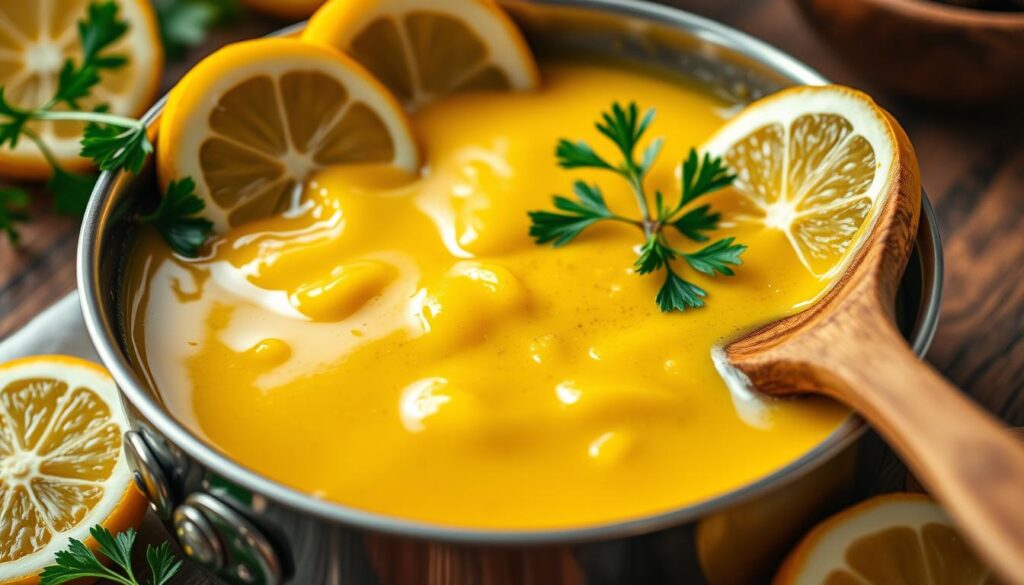
| Ingredient | Quantity |
|---|---|
| Unsalted butter, chilled and cubed | 1/2 cup (115g) |
| Freshly squeezed lemon juice | 1/4 cup (60ml) |
| Dry white wine | 1/4 cup (60ml) |
| Garlic, minced | 2 cloves |
| Olive oil | 1 tablespoon (15ml) |
| Salt and freshly ground black pepper | To taste |
Mastering the Perfect Scaloppine Technique
The art of crafting the quintessential scaloppine is fundamental to the creation of delectable chicken breast dishes. The essence of this technique resides in the meticulous dredging procedure and the adept pan-frying methodology. By honing these steps, one can attain a golden-brown crust while maintaining the chicken’s tender, juicy core.
Dredging Process
Initiate by preparing your chicken breasts for the dredging process. Slice the breasts into thin, uniform cutlets, ensuring uniform thickness. This uniformity is critical for even cooking. Next, establish a dredging station with three shallow dishes: one for all-purpose flour, one for beaten eggs, and one for a breadcrumb-Parmesan mixture.
- Dredge the chicken scaloppine first in the flour, coating both sides evenly.
- Dip the floured cutlets into the beaten eggs, allowing any excess to drip off.
- Lastly, coat the cutlets in the breadcrumb-Parmesan mixture, pressing gently to ensure the breading adheres.
Pan-Frying Methods
With your chicken scaloppine dredged, it’s time to pan-fry them to golden-brown perfection. Heat a large skillet over medium-high heat, adding a generous amount of olive oil or clarified butter. When the oil is hot, add the breaded chicken breasts to the pan, ensuring not to overcrowd the surface.
- Cook the scaloppine for 2-3 minutes per side, until the breading is crisp and golden-brown.
- Avoid overcrowding the pan, as this can cause the chicken to steam instead of fry, resulting in a soggy texture.
- Adjust the heat as necessary to maintain a consistent sizzle and prevent the breading from burning.
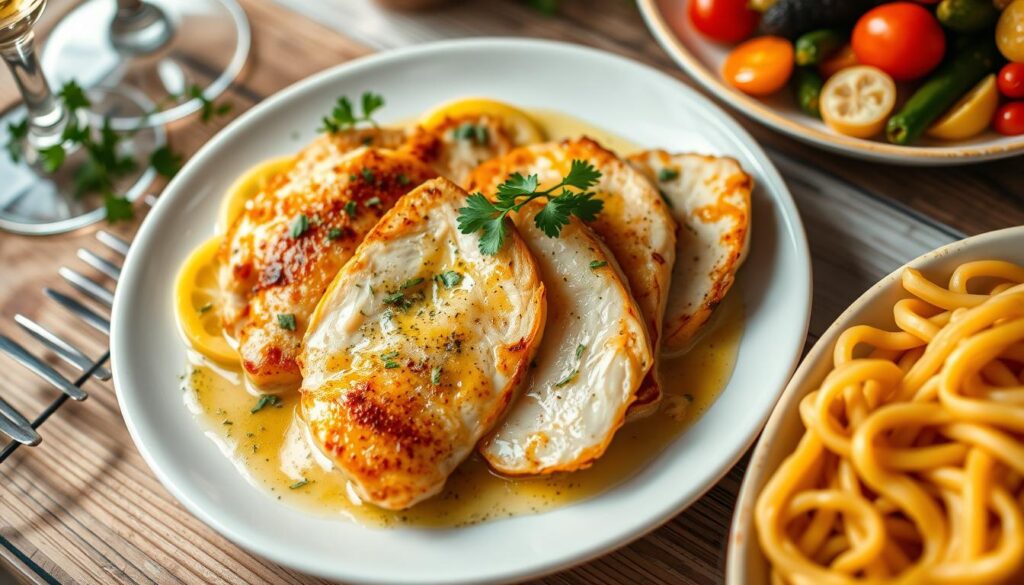
By mastering the dredging process and the pan-frying technique, one can create chicken scaloppine that are crispy on the outside and tender on the inside, serving as the ideal base for your classic Chicken Piccata dish.
The Role of Capers and White Wine
In the quintessential Italian dish of chicken piccata, the incorporation of capers and white wine is instrumental in crafting its distinctive flavor profile. These components are vital to the authentic taste and enduring tradition of this cherished culinary classic.
Capers, the small, pickled flower buds of the Capparis spinosa plant, introduce a bold, briny essence that complements the tender chicken impeccably. These tangy, savory morsels imbue the dish with a Mediterranean flair, evoking the sun-drenched shores of Italy. Coupled with the bright, acidic notes of lemon, the capers achieve a harmonious balance, emblematic of authentic chicken piccata.
The role of white wine in the dish is equally significant. A dry, crisp white wine, such as Pinot Grigio or Sauvignon Blanc, not only deglazes the pan, creating a silky, flavorful sauce, but also adds a subtle complexity to the overall flavor. The wine’s acidity counterbalances the richness of butter and chicken, infusing the dish with the quintessence of Italian cuisine.
Together, capers and white wine synergistically elevate chicken piccata, transforming it from a simple dish into a true culinary masterpiece that embodies the essence of Italian flavors. Whether relished in a cozy trattoria or recreated in one’s own kitchen, the presence of these two essential ingredients guarantees a truly authentic and delectable chicken piccata experience.
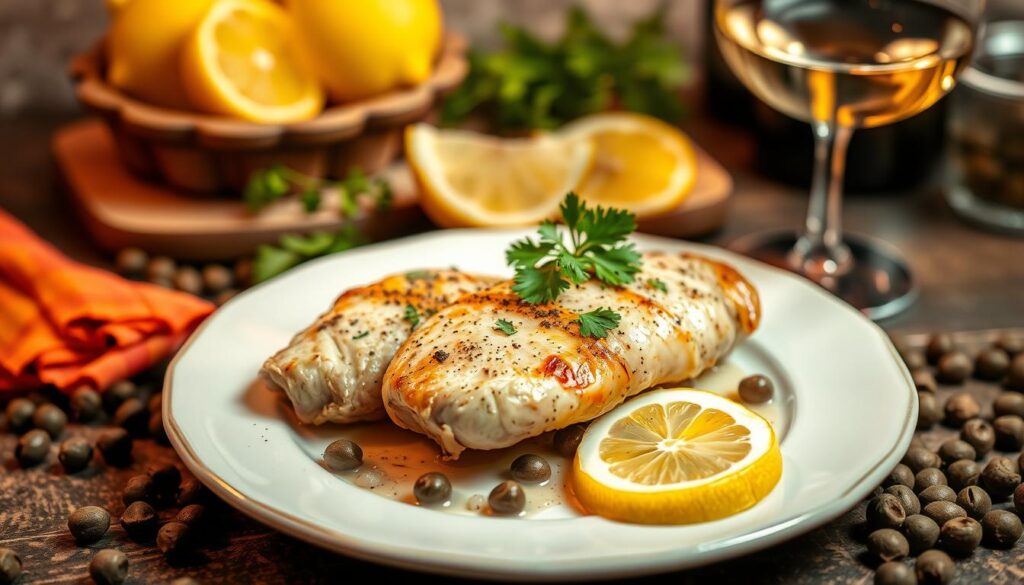
Step-by-Step Guide to Classic Chicken Piccata
Embarking on the journey to prepare a chicken piccata dish within the confines of your domicile is a task of simplicity. This guide is designed to assist you in replicating the quintessential Italian-American culinary delight within your own kitchen environment.
Preparation Phase
Initiate the process by amassing the necessary components: boneless, skinless chicken breasts, all-purpose flour, butter, lemon juice, capers, and white wine. The subsequent step involves the butterfly technique on the chicken breasts to ensure uniformity in cooking. Subsequently, liberally season the chicken with salt and pepper.
Cooking Timeline
- Dredge the chicken breasts in flour, ensuring the removal of any surplus.
- In a substantial skillet, melt butter over medium-high heat.
- Pan-fry the chicken until it attains a golden hue, a duration of 3-4 minutes per side.
- Extract the chicken from the skillet and reserve it.
- In the same skillet, introduce the lemon juice, white wine, and capers.
- Permit the sauce to simmer for 2-3 minutes, during which time, it will extract the caramelized residues from the skillet’s base.
- Return the chicken to the skillet, allowing it to warm through for approximately 2 minutes.
Plating Instructions
Position the chicken piccata on a serving plate, generously spooning the lemon-caper sauce atop. Adorn with fresh parsley or lemon wedges to elevate the presentation to a level akin to a fine dining establishment. Present your easy recipe for chicken piccata immediately, ensuring the chicken remains hot and the sauce retains its vibrancy.
Common Mistakes to Avoid When Making Chicken Piccata
The pursuit of culinary perfection in chicken piccata can be a rewarding endeavor, yet it is fraught with pitfalls that can undermine one’s efforts. As you navigate the intricacies of this dish, it is imperative to be aware of these common errors to ensure your creation reaches its zenith of flavor.
One of the most prevalent mistakes is overcooking the chicken. The essence of this classic Italian-American dish lies in its tender, juicy chicken breasts. Overcooking these can transform them into dry, tough morsels. To circumvent this, it is essential to monitor the chicken’s internal temperature closely, removing it from heat once it reaches 165°F.
Another frequent issue is getting the lemon butter sauce consistency wrong. The ideal sauce should be rich, creamy, and evenly coat the chicken. If the sauce is too thin, it can become watery, diluting the dish’s essence. On the other hand, if it’s too thick, it can overpower the delicate flavors. Achieving the perfect balance in the sauce’s consistency is critical for capturing the quintessential chicken piccata taste.
- Avoid overcooking the chicken to maintain its juicy, tender texture.
- Pay close attention to the lemon butter sauce consistency, ensuring it’s neither too thin nor too thick.
- Ensure the flavors are well-balanced, with the lemon, butter, and capers complementing each other harmoniously.
By avoiding these common pitfalls, you will be well on your way to crafting a chicken piccata dish that will captivate your palate and impress your guests. Achieving mastery over this classic Italian-American favorite is attainable with dedication, practice, and a keen eye for detail.
Pairing Suggestions and Side Dishes
Enhancing your traditional Italian cuisine masterpiece, chicken piccata, is achievable through judicious wine pairing and the selection of complementary side dishes. Whether you are indulging in this restaurant dish within the confines of your domicile or presenting it to your guests, these suggestions will facilitate the creation of a cohesive and satisfying Italian-inspired repast.
Wine Selection Guide
The vibrant, acidic characteristics of chicken piccata are ideally complemented by light, crisp white wines. The following options are recommended for an exemplary wine accompaniment:
- Sauvignon Blanc: Its zesty, herbaceous notes harmonize with the lemon and caper flavors inherent in the dish.
- Pinot Grigio: This Italian varietal’s clean, refreshing profile accentuates the delicate nature of the chicken.
- Chardonnay: For a more substantial pairing, an unoaked Chardonnay with a hint of acidity is advisable.
Complementary Side Dishes
To achieve a harmonious plate, pair your chicken piccata with these delightful side dish options:
- Roasted Garlic Mashed Potatoes: The creamy, savory potatoes serve as an ideal base for the tangy piccata sauce.
- Sautéed Spinach with Lemon: The bright, zesty greens enhance the citrus notes present in the dish.
- Buttered Egg Noodles: The simple noodles allow the chicken and sauce to take center stage.
- Steamed Asparagus with Lemon Zest: The crisp, vibrant asparagus provides a refreshing contrast.
By carefully selecting the right wine and side dishes to accompany your chicken piccata, you can elevate this classic Italian cuisine restaurant dish to unparalleled heights of flavor and enjoyment.
Tips for Restaurant-Quality Results at Home
Attaining restaurant-grade chicken piccata in your kitchen is feasible with certain expert strategies and techniques. This beloved Italian-American dish, renowned for its simplicity and elegance, can be transformed with the right methods. Begin by choosing the most fresh and superior chicken breasts. Then, butterfly them to the ideal thickness, ensuring uniform cooking.
The essence of the lemon butter sauce lies in its harmonious blend of acidity and richness. Gradually add the butter to the pan sauce, blending it meticulously to achieve a smooth, velvety consistency. Feel free to adjust the lemon juice to your liking, tailoring the sauce to your taste.
To achieve the signature sear reminiscent of a professional kitchen, hone your pan-frying skills. Coat the chicken breasts lightly with flour before carefully placing them in the hot oil. Continuously baste the chicken to achieve a golden-brown crust, locking in the juices. The inclusion of capers and a splash of white wine enhances the dish, introducing a briny freshness and depth of flavor.
FAQ
What is chicken piccata?
Chicken piccata is a quintessential Italian-American dish, characterized by its tender chicken breasts, sautéed in a zesty lemon-caper sauce. Renowned for its bold flavors and simplicity, it has become a staple in many restaurants.
What are the key ingredients in chicken piccata?
Authentic chicken piccata relies on chicken breasts, fresh lemon juice, capers, white wine, and a butter-based sauce. These elements combine to create the dish’s distinctive tangy and buttery profile.
How do you properly prepare the chicken for chicken piccata?
To prepare the chicken, butterfly the breasts and then pound them to an even thickness. This ensures even cooking and a delicate texture. Proper seasoning is also essential for maximizing flavor.
What is the purpose of the lemon butter sauce in chicken piccata?
The lemon butter sauce is the essence of chicken piccata, providing a bright, tangy contrast to the chicken. It is crafted by reducing white wine, lemon juice, and butter, resulting in a velvety, flavorful coating.
Why are capers an important ingredient in chicken piccata?
Capers introduce a unique briny and slightly peppery flavor to chicken piccata. They counterbalance the richness of the butter sauce and add a textural contrast to the tender chicken. Capers are a critical component, essential for an authentic Italian taste.
How can you achieve the perfect scaloppine (thin cutlet) texture for chicken piccata?
Achieving the perfect scaloppine texture requires proper butterflying and pounding of the chicken breasts. This thin, even thickness ensures quick cooking and a delicate, golden-brown crust when pan-fried.
What are some common mistakes to avoid when making chicken piccata?
Avoid overcooking the chicken, which can result in dryness and toughness. Also, ensure the lemon butter sauce is balanced and has the right consistency to avoid breaking. These precautions are vital for achieving the best results.
What are some recommended side dishes to serve with chicken piccata?
Pair chicken piccata with simple side dishes that complement its bold flavors. Options include roasted or sautéed vegetables, buttered noodles, or a fresh green salad. The acidity of the lemon sauce also pairs well with a crisp white wine.
How can home cooks achieve restaurant-quality chicken piccata?
To elevate your chicken piccata at home, focus on using high-quality ingredients and proper preparation techniques. Attention to detail, such as proper dredging and achieving the right sauce consistency, is key to recreating a restaurant-quality dish.

